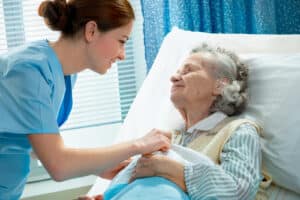 What are they?
What are they?
Bedsores are injuries to the skin and the tissue beneath which is caused by prolonged pressure on the skin, usually most commonly developing on bony areas of the body such as a person’s hips, tailbone, heels, and ankles.
How do they develop?
Bedsores occur when the normal blood supply to the skin is cut off, usually for more than 2 to 3 hours, which causes the skin to die. They can develop quickly, and often first appear as a red, painful area of the skin which eventually will turn purple. The area may feel warm to the touch, and your senior or loved one may complain that the area burns, hurts, or itches.
Are there complications?
If a bedsore is left untreated, the delicate skin can break open which could lead to infection. They can also become so deep that they extend to the muscles, tendons, joints, and bone, and after a serious bedsore develops they can often be very slow to heal, sometimes taking months or even years in some instances.
Factors such as a person’s physical condition and the presence of other diseases like diabetes for example, can affect the healing time. Surgery may be required for healing in some cases.
Who gets them?
Elderly people with medical conditions that prevent them from changing positions or those who spend most of their time in a bed or chair are most at risk for developing bedsores.
People with diabetes, circulation problems, and those with poor nutrition habits are at higher risk as well.
What are treatment and prevention options?
If your senior parent has a bedsore, a treatment plan will be determined by their doctor or health care provider which may include a specialized wound care team depending on the severity of the sore and the condition of their overall health.
If the skin is broken, treating the bedsore may be more difficult and could include removal of any damaged, infected, or dead skin and tissue or the transplantation of healthy skin to the wound area via a procedure called skin grafting.
Medications such as antibiotics are often prescribed as well.
Fortunately, most bedsores are able to heal with proper treatment, but some never heal completely.
There are steps that you or your senior’s caregivers can take to help prevent your parent or loved one from developing painful bedsores, such as:
- Inspecting the skin daily, especially bony areas, for any sign of redness which is the first sign.
- Having caregivers turn and reposition your immobile senior every 2 hours if bed bound, or every 15 minutes if they are sitting upright in a chair or a wheelchair.
- Using soft, thick padding in wheelchairs and on beds to reduce the pressure against their body.
- Keeping the skin clean and dry.
- Being sure that your senior receives proper nutrition to aid in their body’s ability to heal and fight infection.
Source:
https://www.mayoclinic.org/diseases-conditions/bed-sores/symptoms-causes/syc-20355893
https://www.hopkinsmedicine.org/health/conditions-and-diseases/bedsores
If you are considering caregivers in Galleria, TX, for an aging loved one, please call the caring staff at At Your Side Home Care. We will answer all of your senior care questions. Call today: (832) 271-1600.
Our Certified Nurse Aides, 24-Hour Live-in Assistants and Home Health Aides are available 24 hours a day, 365 days a year. We also provide the security and confidence of 24-hour Telephone Assistance, so fast, reliable help is always available when it's needed. To learn more about our homecare services see our homecare services page.
Different people need different levels of homecare. To meet the requirements of our clients, At Your Side Homecare maintains consistent staffing levels of caring professionals. Homecare service is available for as little as a few hours a week, or as many as 24 hours a day, seven days a week
- 5 Signs a Senior Might Be in the Beginning Stages of Dementia - April 25, 2025
- What Solutions Can Help Seniors with Mental Health Challenges? - April 18, 2025
- How Does Senior Home Care Help Make Aging in Place Possible? - April 11, 2025



